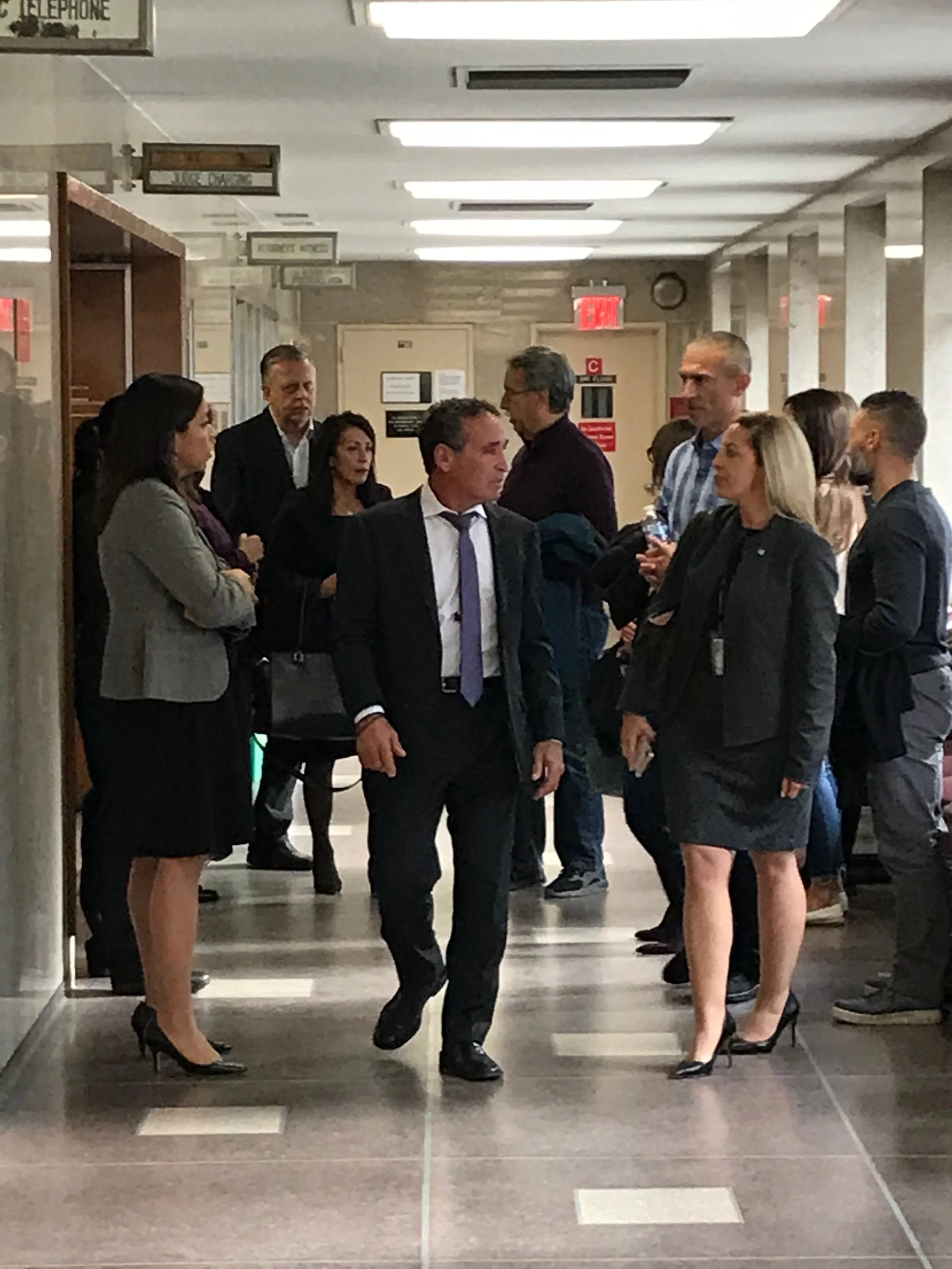‘Purple Was Her Color’: Vetrano Dad Sobs On Stand Recalling Daughter’s Final Run
/
Phil Vetrano (left), the father of 30-year-old Karina Vetrano who was murdered nearby their Howard Beach home in August 2016. // Eagle photo by David Brand
By David Brand
Phil Vetrano sobbed on the witness stand as he recalled his daughter Karina’s fateful jog on Aug. 2, 2016, a run from which she would never return.
“I said to her, ‘I don’t think that’s a good idea,’” Vetrano said. “I felt like something was wrong.”
Vetrano broke down again and collapsed against the wall behind him when confronted by photos of Karina lying face-first and mostly naked in the dense brush of Spring Creek Park — near the family’s Howard Beach home.
Phil Vetrano wore a purple tie to testify on the second day of the murder trial of Chanel Lewis — the man accused of raping and killing Karina. His wife, Cathie, wore a purple shawl that she placed on her lap throughout the trial.
“Purple was her color,” Phil Vetrano told the Eagle when asked if the hue had special significance.
Phil Vetrano testified that he picked up Karina when he found her body, but was separated from her by an NYPD Officer. He told Leventhal he did not disturb her, change her position or the alter the condition of her clothing.
Defense attorney Julia Burke asked few questions of Vetrano during cross-examination.
“When you and Karina would run [in Spring Creek Park], would you see other people?” Burke asked.
“Almost never,” Vetrano responded, adding that he occasionally encountered fishermen headed toward the nearby water.
After Vetrano testified, Assistant Defense Attorney Brad Leventhal asked the court to permit him to watch the remainder of the trial. Judge Michael Aloise approved the application and, after a brief recess, Phil Vetrano joined his wife in the gallery.
Cheung told the Eagle that the defense did not expect to recall Vetrano to the stand.
Leventhal next called NYPD Crime Scene Unit Detective Wendy Enos to the stand. Enos said she arrived at the scene as lead investigator on Aug. 3, 2016 shortly before 12:30 a.m. — six hours after a panicked Phil Vetrano first called friends in the NYPD to say Karina was missing.
Enos described documenting the crime scene evidence, including swabbing the surface of Karina’s cell phone, which laid in the brush about dozens of feet from the body. Enos said she bagged Karina’s hands to prevent contamination and photographed her.
One photograph showed a large red abrasion on Karina’s right buttock. Another showed a dark bruise on the back of Karina’s neck.
Enos told Leventhal that Karina had sustained “some vaginal tearing and some bruising to her anus” as well as “some bruising” to the mouth.
The detective said she did not observe injuries to Karina’s teeth at the time. Prosecutors say Karina’s tooth was broken, an injury consistent with getting punched in the face.
During cross-examination, defense attorney Jenny Cheung questioned Enos about potential disturbances to the scene in the hours before Enos arrived.
“If mistakes happen at the crime scene, there’s nothing you can easily correct,” Cheung said. “There’s no undo button.”
Enos said she did not take elimination samples of other NYPD officers on the scene, did not know how many times the body had been moved or turned, did not recall blood on the cell phone and did not document footprints at the scene.
A necklace that Karina wore — a birthday gift from her parents— was still on Karina’s neck when officers established the crime scene. The necklace was not pictured in a photo of Karina’s bruised neck, however. Another officer had filed the necklace.
The line of questioning about potential disturbances to the scene and potential handling of the body and cell phone seemed designed to counter the prosecutor’s assertion that DNA found on the phone and victim’s fingernails could only match that of Lewis.
Lewis, then 20, voluntarily submitted a DNA sample six months after the murder.
After the prosecution’s opening statement, Cheung requested a mistrial based on the DNA assertion. She told the Eagle that the assertion about the DNA was “exaggerated.”
Throughout the day’s testimony, Cathie Vetrano clutched baby photos of Karina and blew her nose in a hand towel emblazoned with the letter “K.”
Whenever prosecutors and defense attorneys displayed photos of Karina’s body, Cathie leaned forward and grinded the knuckles of her left hand into her forehead. Her other arm’s forearm displayed a tattoo with the face of Karina.
At times, Phil Vetrano placed his hand on Cathie’s back and stared at Lewis, who sat leaning forward with his left elbow on the table and his head resting in his left palm for the majority of the day.
About 30 of Karina’s family members, friends and neighbors sat in the left side of the gallery. At least one observer said he attended court to support the Lewis family, though he did not know them.
The observer, an older black man, said his name was Vincent but declined to give a last name. Vincent said he began following the trial when he saw the Vetrano family surrounded by “an entourage of law enforcement officers” during a TV news report in August 2016.
“I thought there was something very strange in the reporting,” Vincent said. “I felt there was going to be someone of color who was accused [and that] they’d find a scapegoat.”
Vincent said he did not think Lewis committed the crime and questioned why Phil Vetrano was able to summon a large-scale NYPD search party complete with a helicopter and canine unit without calling 911.
In a statement to the Eagle Monday, a spokesman for the Lewis family, Chris Banks said the family remained steadfast in the belief that Lewis is innocent. He acknowledged that both families were struggling.
“This is very hard for both families,” Banks said.
Cathie Vetrano gripped a wooden cross as Lewis’s mother, Veta, read the Bible.




